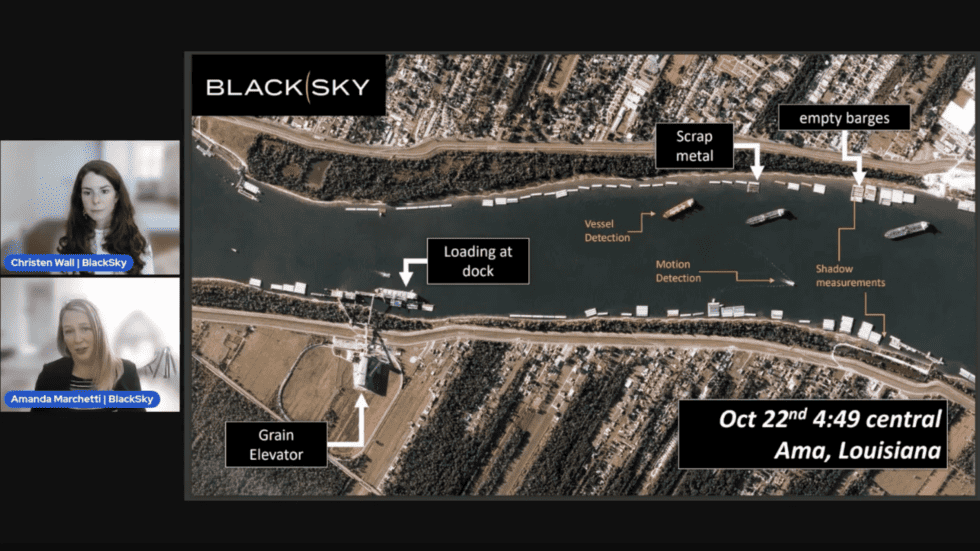
The Mississippi River dropped to the lowest depth ever recorded in Memphis, Tennessee in 2022.1 In addition to the environmental impacts, persistent drought conditions affect commodity flow and commerce in ways that are difficult to predict in terms of magnitude and timing.
Data analytics can offer some insight but falls short without real-time data capture capabilities. For example, some monitoring and mapping tools show cleared land where there are now storage facility construction sites. Barges on the water presumed to be in motion remain in place, relieved of cargo as water levels can no longer support their loads. These and other situational conditions are often missed by current intelligence gathering methods.
Burdened with these debilitating blind spots, the commodities and associated markets are encountering costly bottlenecks and supply chain uncertainties that further compound the economic impact of the historic Mississippi River drought.
Drought conditions and the economic toll
The ongoing Mississippi River drought provides a case study on how some of these challenges manifest in the market. The availability of dry bulk commodities ebbs and flows as the drought changes how commodities flow up the river.
Drought can affect vessel movement, cargo, and port access. The lower water level restricts traffic, leading to congestion delays and limited bulk goods capacity on barges. Anticipating these fluctuations is key to controlling or avoiding cost increases and price spikes.
Impact on a vast spectrum of industries
Farming and agricultural trade suffers from the wide impact of these supply chain bottlenecks. AgAmerica Lending highlights transportation bottlenecks as a top disruption and cause of increasing costs to farmers.
The Mississippi River drought is causing shipping price spikes in a river basin that produces 92 percent of the nation’s agricultural exports, according to Bloomberg. The Associated Press reports that “the river moves more than half of all U.S. grain exports but the drought has reduced the flow of goods by about 45 percent.”
In addition to the narrowing channels that limit the number of barges, the lower water levels decrease barge capacity. The Arkansas Farm Bureau Ag Insider explains how this forces grain elevators around the Mississippi River to store grain longer. With less storage available, elevators offer grain producers less than the going price of futures contracts.
The Mississippi River drought also significantly affects public health and the environment. On PBS NewsHour, William Brangham reports that “as the river’s freshwater shrinks, saltwater from the Gulf pushes further upstream, threatening the drinking supply used by residents south of New Orleans.” These ecosystem changes threaten everything from wildlife to tourism to jobs.
Status quo solutions to predict and manage commodity flow disruption
Most efforts to understand and predict on-the-ground changes along supply chains rely on offline monitoring techniques that do not incorporate digital platforms. Commodity brokers and analysts are hungry for real-time intelligence to predict supply chain disruptions and financial market impacts, but often rely on older methods of data collection and communication. Even newer tools like Google Earth and security cameras only provide snapshots or single-location views. Supply & Demand Chain Executive points to a Boston Consulting Group finding that “there is $70 billion to be gained in incremental value from commodities trading deploying appropriate technologies.”
Bringing a bold solution down to Earth
Deloitte Managing Director and Global AI and Analytics Services Leader Rohit Tandon points toward a solution by noting on CNBC that “[Artificial Intelligence] can predict a range of unexpected events, such as weather conditions, transportation bottlenecks, and labor strikes, helping to anticipate problems and reroute shipments around them.”
But what if Artificial Intelligence (AI) models were enhanced with data from real-time satellite imagery? Advances in dynamic, location-based monitoring from space enable a slew of new data collection capabilities that go beyond Google Earth and on-site camera feeds. These AI-driven capabilities, such as BlackSky’s, enable analytics that provide a deeper situational understanding. Historically used for only defense and intelligence applications, innovative developments are making this technology more accessible and attractive for tackling commercial challenges.
To learn how real-time geospatial intelligence can help inform your supply chain decisions, watch Using BlackSky to Gain Stockpile Commodity Insight on the Mississippi River from a recorded LinkedIn Live or contact us here.
References:
1 Historic drought brings eerie objects and seawater to the surface of the Mississippi River (Popular Science, October 2022):
https://www.popsci.com/environment/mississippi-river-low-levels-shipwreck/
Three Ways Supply Chain Bottlenecks are Impacting U.S. Ag Trade (Ag America Lending, April 2022):
https://agamerica.com/blog/supply-chain-bottlenecks/
Mississippi River Drought Imperils Trade on Key U.S. Waterway (Bloomberg, October 2022):
https://www.bloomberg.com/news/articles/2022-10-06/mississippi-river-drought-imperils-trade-on-vital-us-waterway
Drought snarls Mississippi River transit in blow to farmers (The Associated Press, October 2022):
https://apnews.com/article/science-business-droughts-mississippi-river-22db8e44d7f1f96b7e0ed32c9c77f621
Ag Insider (Farm Bureau Arkansas, October 2022):
https://www.arfb.com/uploads/resources/documents/aginsider_barge__freight_oct.2022.pdf
Drought’s impact on Mississippi River causes disruptions in shipping and agriculture (PBS NewsHour, November 2022):
https://www.pbs.org/newshour/show/droughts-impact-on-mississippi-river-causes-disruptions-in-shipping-and-agriculture
The Physical Nature of Commodities Trading and the Associated Supply Chain Risks (SDC Executive, May 2021):
https://www.sdcexec.com/sourcing-procurement/article/21403460/helixtap-technologies-the-physical-nature-of-commodities-trading-and-the-associated-supply-chain-risks
How using analytics and AI can help companies manage the semiconductor supply chain (CNBC, October 2022):
https://www.cnbc.com/2022/10/19/how-ai-can-help-companies-manage-the-semiconductor-supply-chain.html
Using BlackSky to Gain Stockpile Commodity Insight on the Mississippi River (BlackSky, November 2022):
https://www.linkedin.com/video/event/urn:li:ugcPost:6993250595868401664/

